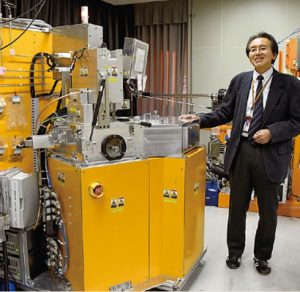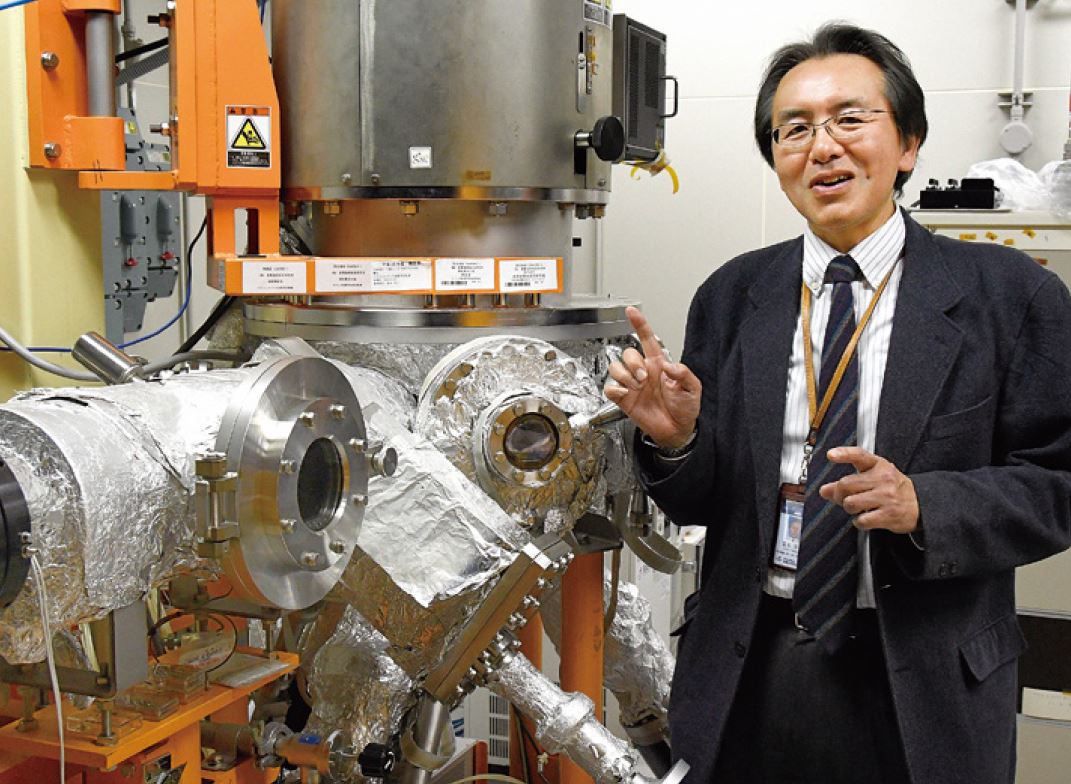This post is also available in: Japanese
A topological insulator is what I’m working on now.
――So that was not the end of your phasechange research.
Actually, a superlattice in which GeTe and Sb2Te3 in crystallized states were stacked reduced the energy requirement of phase-change memory, and I thought that would be the end of it. Because of the Great East Japan Earthquake that occurred on March 11, 2011, I was unable to conduct any experiments for a while, so I decided to read a variety of technical papers. I ran into the strange term “topological insulator.” Then I found out that Sb2Te3 is a topological insulator. I became really interested, since the superlattice memory I had been working on used the same material, but at first I could not understand anything from reading. Nevertheless, I felt that there was huge potential there. As the Japanese proverb says, repeated reading made the meaning clear.
Since there was a professor who was researching this subject at the Tokyo Institute of Technology, I decided to visit him to ask for more details. During the visit, he gave me some homework, and when I got home I carried out a simulation. I was able to definitely confirm the phenomenon the professor had described.
The process involved using a magnet to destroy the time-reversal symmetry of electron spin. The device repeated the “set” state, indicating low resistance, and the “reset” state, indicating high resistance. When I brought a magnet close to the device during this cycle, the resistance value surged and got stuck in the high-resistance state, and would not return to the low-resistance state. Thinking that it might have broken, I removed the magnet, and then the device returned to the low-resistance state. I realized that this phenomenon had something to do with electron spin. So I have started a spin control project and am currently researching topological insulators.
I’m convinced that if we can develop practical applications for topological insulators, they will be welcomed as an important technology in support of the AI and IoT society of the future. (For details, this page.)
Agreeing with Yozan Uesugi’s famous saying, “Where there is a will, there is a way”

――What is your policy on research activities?
I have just one policy. I am particularly interested in things that others have deemed impossible. I fully agree with the famous maxim by Yozan Uesugi, the feudal lord of the Yonezawa Domain in Yamagata: “If you try, you can achieve it; if you don’t, it will never be achieved. It was not achieved because you didn’t try.” I interpret this maxim to mean that you cannot achieve something if you have already decided you won’t be able to, and you can achieve it if you try. My research activities are guided by a philosophy like this.
When you read technical papers in some research field, you often notice issues that nobody has addressed or that have been overlooked. I approach this with the attitude of, “I must solve these issues.” For example, when I moved from TDK to AIST, I began research using light. Rather than just watching a scanning tunneling microscope (probing microscope), which uses proximity field light, I wondered if I could apply this to some mechanism for making things. Since a probing microscope uses light to view atoms, it has atomic-level resolution. This idea became the starting point for my development of optical super-resolution thin film technology in 2009.
Superlattice phase-change memory also uses the same technology. In phase-change memory, material goes back and forth between crystallized and amorphous (set and reset) states. As I mentioned earlier, there is always some energy loss. I had thought it would be interesting to fundamentally overturn this situation, and I developed superlattice phase-change memory with crystal- to-crystal phase transition. At that time, many people said it could never be done. I thought, who decided that it can never be done? It seemed to me that it had simply never been tried. I think focusing on areas being overlooked by everyone and creating something useful is the mission of researchers.
* The first law: The increase in energy inside a system is equal to the sum of the work and heat added from outside. This is the law of conservation of energy, including heat.
The second law: Increasing the thermal energy of a system (moving a system from a lower temperature to a higher temperature) is not possible in an otherwise unchanging system. This is the principle that entropy in an isolated system can never decrease over time.
The third law: The entropy of any given substance is zero at absolute zero (0K). Absolute zero cannot be reached through a finite number of processes. This is also referred to as Nernst’s heat theorem.

